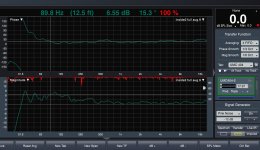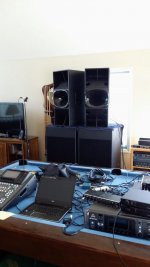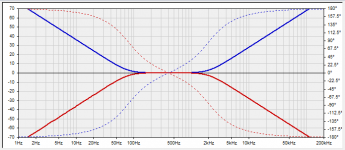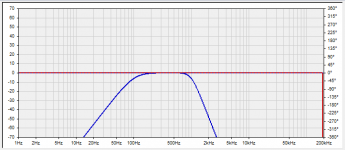Hi Thomas,

it can be hard for a single driver (with limited bandwidth)
Why don't apply directly the target from an another instance,in a free bank (once the measurement is flattened) ?
Hi Thierry,
You are absolutely right
In fact the compensate "trick" applies when you load an existing target curve (measurement) and want to "apply" it on your correction.
In that case you will want to "flatten" that curve using EQs and compensate filters, and then "reverse" them and apply those on your actual correction.
I also used that trick to generate the minimum-phase response of a measurement mic calibration file which only had magnitude data.
Last edited:
There are many possible use of the "compensate" filters:My use of 'compensate' so far, has been to think of it in the same way as the "Box" and "Subsonic" fields work in the Minimum-Phase Filters Linearization tab.
Is this a proper use of compensate?
I guess understanding how 'compensate' works, along with the comment that phase eq should not be needed driver by driver, is what I'm trying to get a grip on....
-compensate for an actual protection filter in the measurement
-"delete" and existing rolloff and replace it with your target (some sort of generalized LT)
-set an inverted target and try to reach it (house curves, mic calibration, etc.)
etc.
And of course if some of these cases you will want to actually remove the compensate filter before generating the impulse...
Thomas, thank you very much for your replies....they help !
I'm getting better at limited bandwidth, driver by driver tuning using rePhase...or at least measurements are verifying things are improving.
Here's a measurement indoors, horn loaded sub and mid, coaxial compression.
6144 taps on sub and mid, 2048 on HF and VHF. (Aug9 date was Apr9...too much wine haha). x-over all 48LR's @100, 650, and 6300.
I can't believe how relatively easy it is to tune with flat phase, compared to trial and error of matching phase slopes using IRR. Looking forward to further tuning outdoors..
Again, rePhase totally rocks...thank you !
I'm getting better at limited bandwidth, driver by driver tuning using rePhase...or at least measurements are verifying things are improving.
Here's a measurement indoors, horn loaded sub and mid, coaxial compression.
6144 taps on sub and mid, 2048 on HF and VHF. (Aug9 date was Apr9...too much wine haha). x-over all 48LR's @100, 650, and 6300.
I can't believe how relatively easy it is to tune with flat phase, compared to trial and error of matching phase slopes using IRR. Looking forward to further tuning outdoors..
Again, rePhase totally rocks...thank you !
Attachments
mark100,
Your plot show nice datahaving a listening position in same spot as where mic was placed must sound pretty good.
Thanks BYRTT !
I tune to outdoors and seldom measure inside. But I was dying to see how well rePhase and 6144 taps could do at phase flattening below 100hz.
Frankly, I was a little surprised to see fairly decent indoor flatness at lower freqs. Lucky mic position I guess...
The phase flattening is what really has me psyched..can't wait for outdoor testing...
It's PA gear..sweet spot is 20 meters wide
3 or 4 way IIR crossovers are indeed very difficult to get right, because you cannot simply shoot for textbook LR acoustical filters for each of your drivers, as you have to take into account the influence of each crossover point on the other channels: Woofer crossover & offsetI can't believe how relatively easy it is to tune with flat phase, compared to trial and error of matching phase slopes using IRR
Ok. I accept that there will be now display of the Target Curve in near Future or never.
For Noobs like me it is very hard to work with compensate filters etc. In fact I do not understand how this should work and i did not find an example where these Things are explained the way i could do it on my own. (Perhaps i am getting to old, perhaps my English is too bad ; School´s out for over 30 Years now, perhaps a combination of all of these Things )
)
What a about the possibility of importing the EQ-Text File from RoomEQWizard?
(That is what I am doing quite often, let REW "suggest" some Filters and copy them manually to rePhase)
rePhase will stay completly "manual" and Noobs like me could use automatic Functions.
I am using rePhase to build Impulse Filters for Brutefir it is a fantastic Tool for me right now and the only reason why there is a WindowsVM on my Linux Desktop. (Yes, this is a silent hint, that I wish rePhase will be ported to Linux sometimes.....)
(Yes, this is a silent hint, that I wish rePhase will be ported to Linux sometimes.....)
Regards
For Noobs like me it is very hard to work with compensate filters etc. In fact I do not understand how this should work and i did not find an example where these Things are explained the way i could do it on my own. (Perhaps i am getting to old, perhaps my English is too bad ; School´s out for over 30 Years now, perhaps a combination of all of these Things
What a about the possibility of importing the EQ-Text File from RoomEQWizard?
(That is what I am doing quite often, let REW "suggest" some Filters and copy them manually to rePhase)
rePhase will stay completly "manual" and Noobs like me could use automatic Functions.
I am using rePhase to build Impulse Filters for Brutefir it is a fantastic Tool for me right now and the only reason why there is a WindowsVM on my Linux Desktop.
Regards
The curves look nice indeed!
Care to share some pictures of your rig?
Thx! Somebody wrote a good curve fixer
Here's a pict of the boxes that go with the measurements...
Attachments
3 or 4 way IIR crossovers are indeed very difficult to get right, because you cannot simply shoot for textbook LR acoustical filters for each of your drivers, as you have to take into account the influence of each crossover point on the other channels: Woofer crossover & offset
Yes, fortunately for me in the case of this box, all the heavy lifting was done by a very gifted, sharing designer. He's tuned it the point of near perfect impulse response, as well as very good off-axis performance, using Lake processing.
I've just copied his suggested crossover points....https://soundforums.net/threads/12075-60-Degree-DIY-Mid-Hi
.....For Noobs like me it is very hard to work with compensate filters etc. In fact I do not understand how this should work and i did not find an example where these Things are explained the way i could do it on my own. (Perhaps i am getting to old, perhaps my English is too bad ; School´s out for over 30 Years now, perhaps a combination of all of these Things).....
Have a try to explain compensate filters : )
You know having a audio device with unlimited bandwidth from DC to light speed will be perfect audio device, in it have totally flat amplitude and phase inside and outside of audio band. Real speaker drivers have limited bandwidth and are minimum phase devices, so if their fall off slopes outside their stop bands is corrected with high SPL numbers of minimum phase correction they in theory end up be a DC to light speed device.
Below example red trace should simulate a mid-bass when mounted in a sealed box that end up a 2nd order 80Hz roll off and in HF area it rolls off 2nd order at 2kHz, and lets say all peaks and dips including break up modes is corrected with minimum phase (IRR) EQ at "Paragraphic Gain EQ" tab or corrected with passive filter components. Blue trace is if we look isolated at how compensate mode correct for a HP 2nd order 80Hz point plus a LP 2nd order 2kHz point. It's the IRR reverse mode of driver itself and will correct driver to now be perfect linear phase wide bandwidth device.
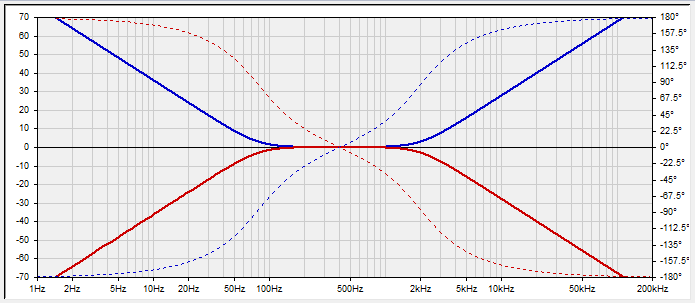
Result of above red trace corrected with blue trace would be as below red trace, but it won't work in real world because audio system lack dynamic range to correct for so much EQ boost and driver itself won't like that much boost and also won't perform good sound outside its intended pass band. But now we can add new stop bands that is inside drivers intended pass band working area in Rephase's "Linear-Phase Filters" tab that only correct for amplitude and leave phase as is (FIR filter), blue trace below is that correction with HP LR4 at 100Hz and LP LR8 at 1kHz.
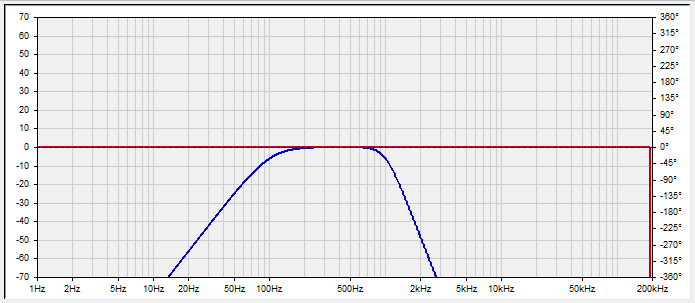
In real world think to hit the right compensate filter will take some hack time to hit right filter, by sweeping up and down frq point and try different order of slope or mix multiple slopes. High pass compensate mode for sealed box should be second order, vented fourth order, and guess OB be first order and leaking box be third order.
Attachments
Last edited:
Hi skyunlimited.
I hope BYRTT's nice examples will make things clearer for you.
I apology for the lack of documentation
If it is a formatted list of EQ points (fs, Q, gain for example) then it can probably implemented easily.
If it is a list of biquads then I would have to add a specific tab, and cope with the different biquad conventions that exists...
As for the linux hint...
Yes it could be made to work, maybe in the future...
I hope BYRTT's nice examples will make things clearer for you.
I apology for the lack of documentation
What does this export format look like?What a about the possibility of importing the EQ-Text File from RoomEQWizard?
(That is what I am doing quite often, let REW "suggest" some Filters and copy them manually to rePhase)
rePhase will stay completly "manual" and Noobs like me could use automatic Functions.
If it is a formatted list of EQ points (fs, Q, gain for example) then it can probably implemented easily.
If it is a list of biquads then I would have to add a specific tab, and cope with the different biquad conventions that exists...
As for the linux hint...
Yes it could be made to work, maybe in the future...
RoomEQwizard gives us a simple Textfile ( File > Export >Filtersettings as text).
This is a Demo File:
Regards
This is a Demo File:
Code:
Filter Settings file
Room EQ V5,14
Dated: 24.04.2016 19:36:33
Notes:W5-2143
Equaliser: Generic
Apr 11 10:42:43
Filter 1: ON PK Fc 3.834 Hz Gain -6,9 dB Q 5,00
Filter 2: ON PK Fc 173 Hz Gain -2,8 dB Q 2,00
Filter 3: ON PK Fc 9.126 Hz Gain -6,1 dB Q 5,00
Filter 4: ON PK Fc 2.361 Hz Gain -3,5 dB Q 3,03
Filter 5: ON PK Fc 14.906 Hz Gain -5,4 dB Q 5,00
Filter 6: ON PK Fc 10.695 Hz Gain -4,0 dB Q 3,87
Filter 7: ON PK Fc 863 Hz Gain -4,9 dB Q 5,00
Filter 8: ON PK Fc 7.691 Hz Gain -4,4 dB Q 5,00
Filter 9: ON PK Fc 1.802 Hz Gain -2,9 dB Q 5,00
Filter 10: ON PK Fc 1.439 Hz Gain -2,5 dB Q 5,00
Filter 11: ON None
Filter 12: ON None
Filter 13: ON None
Filter 14: ON None
Filter 15: ON None
Filter 16: ON None
Filter 17: ON None
Filter 18: ON None
Filter 19: ON None
Filter 20: ON NoneRegards
Attachments
This is a question i can not answer. Here is something i found in the REW Documentation: Equaliser Selection
I am using the Generic Type with good Results.
Regards
I am using the Generic Type with good Results.
Regards
Thanks
The description states it is "based on the Robert Bristow-Johnson 'Cookbook' equations", so these are proportional Q EQs.
It allows up to 20 EQs of different types, including the notch that I don't currently implement as is in rephase. So this would definitely not fit in a single paragraphic EQ bank where I intended to fit it.
As it currently is the closest thing would be the Xilica XP2040 export: 16 PEQ, that would fit nicely in a bank after converting those BW into Qs...
The description states it is "based on the Robert Bristow-Johnson 'Cookbook' equations", so these are proportional Q EQs.
It allows up to 20 EQs of different types, including the notch that I don't currently implement as is in rephase. So this would definitely not fit in a single paragraphic EQ bank where I intended to fit it.
As it currently is the closest thing would be the Xilica XP2040 export: 16 PEQ, that would fit nicely in a bank after converting those BW into Qs...
Last edited:
Have a try to explain compensate filters : )
You know having a audio device with unlimited bandwidth from DC to light speed will be perfect audio device, in it have totally flat amplitude and phase inside and outside of audio band. Real speaker drivers have limited bandwidth and are minimum phase devices, so if their fall off slopes outside their stop bands is corrected with high SPL numbers of minimum phase correction they in theory end up be a DC to light speed device.
Below example red trace should simulate a mid-bass when mounted in a sealed box that end up a 2nd order 80Hz roll off and in HF area it rolls off 2nd order at 2kHz, and lets say all peaks and dips including break up modes is corrected with minimum phase (IRR) EQ at "Paragraphic Gain EQ" tab or corrected with passive filter components. Blue trace is if we look isolated at how compensate mode correct for a HP 2nd order 80Hz point plus a LP 2nd order 2kHz point. It's the IRR reverse mode of driver itself and will correct driver to now be perfect linear phase wide bandwidth device.

Result of above red trace corrected with blue trace would be as below red trace, but it won't work in real world because audio system lack dynamic range to correct for so much EQ boost and driver itself won't like that much boost and also won't perform good sound outside its intended pass band. But now we can add new stop bands that is inside drivers intended pass band working area in Rephase's "Linear-Phase Filters" tab that only correct for amplitude and leave phase as is (FIR filter), blue trace below is that correction with HP LR4 at 100Hz and LP LR8 at 1kHz.

In real world think to hit the right compensate filter will take some hack time to hit right filter, by sweeping up and down frq point and try different order of slope or mix multiple slopes. High pass compensate mode for sealed box should be second order, vented fourth order, and guess OB be first order and leaking box be third order.
BYRTT, a very nice and clear illustration and explanation.
thanks
REW
You do NOT need to install a Full Java package There are versions of REW which come with it's own Very light install of Java Index of /installers
There are versions of REW which come with it's own Very light install of Java Index of /installers
Originally Posted by pos
Gotta reinstall REW (which means reinstalling a JRE )
You do NOT need to install a Full Java package
- Home
- Design & Build
- Software Tools
- rePhase, a loudspeaker phase linearization, EQ and FIR filtering tool
